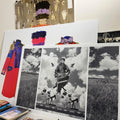8 Essential Western paintings at New Mexico Museum of Art
By Chadd Scott on
What could be more “essentially Western” than visiting the New Mexico Museum of Art’s Santa Fe Plaza location to enjoy its collection of Southwestern art? Opened in 1917 as the first building in the state dedicated to art, the museum has maintained its mission of collecting and displaying contemporary artwork relevant to New Mexico for more than century.
I visited in December of 2023 and would like to share the paintings I found most “essentially West.” All of these artworks are in the museum’s permanent collection, but depending on when you visit, all may not be on view.

Awakening, (Memory of Father), 1943. Agnes Pelton (Image Courtesy New Mexico Museum of Art)
I had written about this sensitive, luminous, celestial, moody, bring-you-to-tears masterpiece previously, but not seen in in person before. Mercy.
It is one of the finest paintings I’ve ever seen bar none.
Delicate, soft, precious.
I half wonder if turning away from the painting will cause it to evaporate so light, spiritual, and seemingly ephemeral is its presence.
The picture is a classic example of the short-lived Transcendental Painting Group which formed in New Mexico in the late 1930s with the goal "to carry painting beyond the appearance of the physical world through new concepts of space, color, light and design to imaginative realms that are idealistic and spiritual,” according to its manifesto.

Drouth Survivors, 1984. Alexandre Hogue (Image Courtesy Chadd Scott)
On a planet being made increasingly unlivable by man’s runaway consumption of fossil fuels and the resultant climate changes, Hogue’s artwork feels like a warning sent from the past. Not that anyone’s listening.
Hogue focused his art making on the Dust Bowl of the 1930s, another man-made environmental catastrophe, that one caused by large-scale monoculture farming, farmers overworking the soil, removal of native grasses across the great plains and a broader, nationwide deforestation.
Hogue probably wasn’t the first “environmentalist” artist – he may not even have embraced that term – but he’s the first artist I’ve found who so heavily worked overt themes of environmentalism and conservation into his paintings. Today, artists responding to climate change and biodiversity collapse are the norm, 100 years ago, Hogue stood nearly alone.
Interestingly, this painting was first conceived and produced in 1936. Hogue sold it to the French government in 1938 and was told it subsequently burned in a fire. He reproduced it in 1984, equally unaware the original had, in fact, survived.

Washington Landscape with Peace Medal Indian, 1976. T.C. Cannon (Image Courtesy Chadd Scott)
The great T.C. Cannon (Kiowa-Caddo) was only 31-years-old when a car accident took his life in 1978. Considering the caliber of work he was producing in his 20s, like this painting, it’s impossible to imagine where his creativity might have led. And heartbreaking.
Like Jean-Michel Basquiat or Vincent van Gogh, artists whose talent Cannon’s was on par with and similarly died young, all of humanity lost something when he passed.
In this painting, produced in America’s bicentennial year, Cannon takes viewers back to the 19th century and one of the dog-and-pony-show invitations of a Plains Indian tribal leader to Washington for receipt of a peace medal. Notice the Capitol Dome in the window.
Peace medals were awarded by the federal government when a peace treaty was signed between a tribe and the expanding nation. They often included invitation to Washington, as Cannon demonstrates.

Untitled (Self-Portrait), 1971. Fritz Scholder (Image Courtesy Chadd Scott)
Fritz Scholder (Luiseño) can be considered the first Native American artist to break through into mainstream contemporary art in America. Scholder didn’t lean into his Native heritage like Cannon, however, generally attempting to distance himself from the “Indian artist” label.
Scholder was building his career at a time when a Native couldn’t infuse his/her work with Indigenous themes and simultaneously be taken seriously by the broader contemporary art world. Collectors and museums held Native art in the past. The old ways. “Flat” paintings, “Bambi painting,” the Dorothy Dunn Santa Fe Indian School stuff.
Scholder and Cannon began chipping away at the wall separating contemporary Native American artists from the contemporary art world and are more responsible than any other figures for initiating what has finally become the mainstream contemporary art world’s full embrace of Native American art.
Here, Scholder responds to Francis Bacon, a mid-century contemporary British painter best known for his self-portraits. Cannon, similarly, is engaging with modernism in Washington Landscape with Peace Medal Indian, incorporating the bold, blocky patterns of Pop Art and background compositions elements inspired by van Gogh.
Scholder and Cannon show how Native artists were participating in the conversation of Modern art, even if that world wanted to exclude them.

Pablita Passes (Walking Rain), 1916. Victor Higgins (Image Courtesy Chadd Scott)
Higgins is my favorite of the original Toas Society of Artists. His straight landscape paintings, like this one, have never been exceeded.
Wall text beside this painting at the New Mexico Museum of Art explains how Pablita was a young Hispanic girl who often modeled for Higgins and died of a fever. In the foreground, figures gather to mourn her. The rainbow represents her transcendence to heaven.

Cui Bono,?, 1911. Gerald Cassidy (Image Courtesy Chadd Scott)
Brilliant light reflects off the figure in white depicted at nearly life-size in this painting. Onlookers may feel themselves squinting, as if in the scene with this man trying to find relief from an unrelenting New Mexico sun.
Cui bono is a legal term meaning, “who benefits?”
The artist is asking that question on behalf of his anonymous subject from Taos Pueblo; New Mexico was seeking admission to the United States and its statehood would be granted the year after this painting was produced.
Cassidy knew everyone would not benefit from that development and that those who would be most harmed had the least say on the issue.
Night of the Yei, 1960. R.C. Gorman
R.C. Gorman belonged to that first wave of Modernist Native painters like Scholder and Cannon who found footing in the mainstream contemporary art world. Reproduction prints and posters of his work are ubiquitous around the Southwest.
Gorman was also an entrepreneur. When he opened his Navajo Gallery in Taos in 1968, it became the first Indigenous-run art gallery in the nation.
Yei is a spiritual being and central figure in certain Navajo ceremonies which Gorman depicts here.
El Santo, 1919. Marsden Hartley
Marsden Hartley is a giant Modernism, nearly on a par with the likes of Cézanne and Matisse. His artworks are highlighted in the most prestigious art museums on both sides of the Atlantic.
Hartley first visited New Mexico in 1918.
“I am an American discovering America,” he commented at the time.
Hartley was much more successful in capturing the atmosphere and aesthetic of the area than many eastern artists. Here, he comments on New Mexico’s combination of cultures. Notice the Catholic priest in the background, referencing Spain’s invasion of the region, a Native textile and black-on-black pottery piece in the foreground, representing the Indigenous inhabitants.
He does so with his archetypally vivid, rich, luscious, matte paint application.



